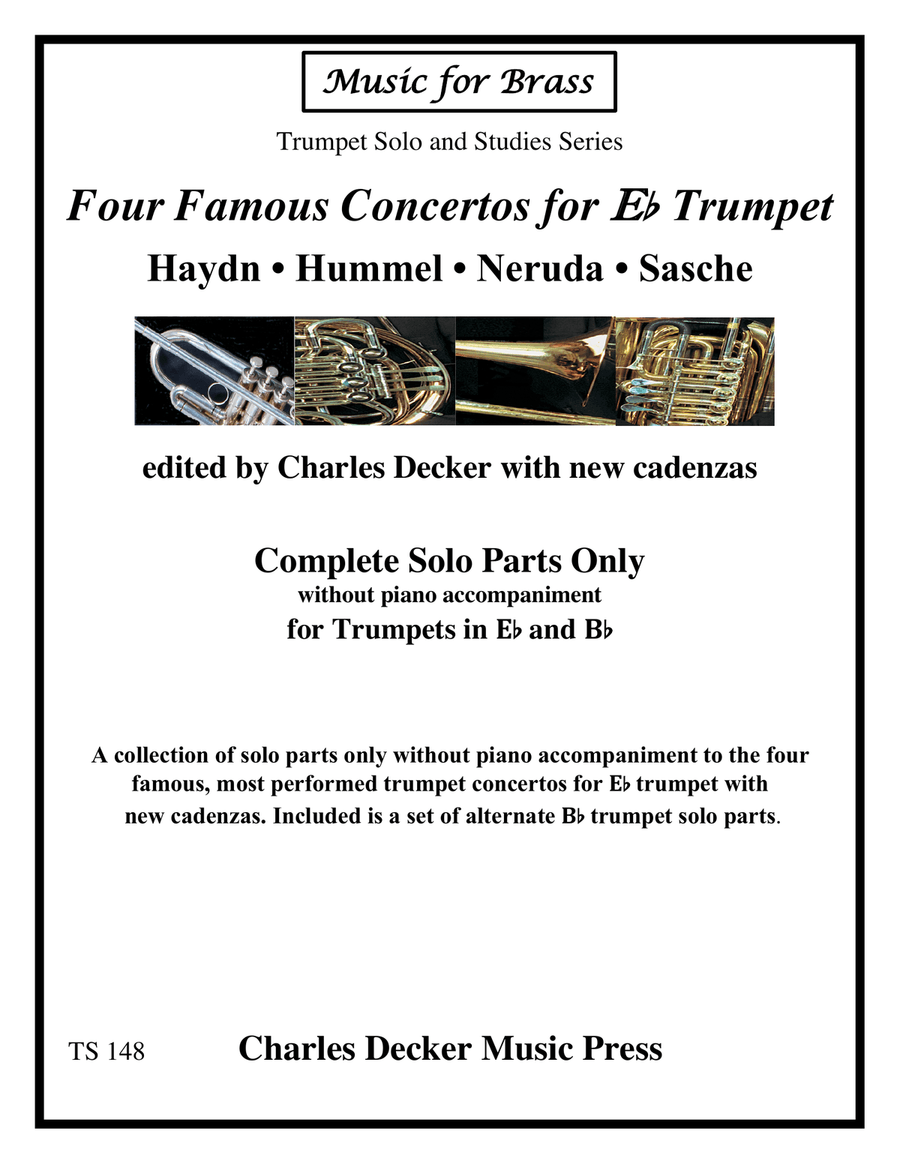Trumpet Solo - Level 5 - Digital Download SKU: A0.817140 Composed by Franz Joseph Haydn, Johann Nepomuk Hummel, Neruda, and Sasche. Arranged by Charles Decker. Classical,Contest,Festival,Historic,Instructional,Romantic Period. Individual part. 53 pages. Charles Decker Music Press #3905635. Published by Charles Decker Music Press (A0.817140). Now in in one collection are the four famous concertos for E-flat trumpet by Franz Josef Haydn (1796), Johann Nepomuk Hummel (1803), Johann Baptiste Neruda (ca. 1750) and Sasche (1871) that are the core of the trumpet's solo literature edited with dynamics, articulations, and new cadenzas. This essential collection for ambitious trumpeters comes with two sets of solo parts for E-flat trumpet and B-flat trumpet with no piano accompaniment. For more trumpet study materials to improve performance capabilities and musicianship see my Intermediate Serial Studies for Trumpet (highly recommended by the International Trumpet Guild Journal) and Supplemental Practice Approaches for Trumpet, as well as my First Technical Studies for Trumpet for young students, all with Charles Decker Music Press at Sheet Music Plus. To further expand your solo literature knowledge see my collection at Sheet Music Plus of Three Famous Baroque Works for Two Trumpets which has D, C, piccolo A and B-flat trumpet solo parts for the frequently performed Vivaldi and Manfredini Concertos and Francheschini Sonata. If looking for more trumpet solo features with brass quintet check out my SMP editions of Clarkeâs Carnival of Venice, Pucciniâs Che Gelida Manina from La Boheme, Verdi's Caro Nome from Rigoletto, Rossini's Non Piu Mesta from Cinderella, Sasche Concertino for Eb Cornet of 1871, and use this like to Kendor Music for my editions of Clarkeâs Bride of the Waves and Nesticoâs Portrait of a Trumpet. See 50+ homogeneous brass group editions for horn, trumpet and trombone ensembles and more than 70 mixed brass ensemble publications with Charles Decker Music Press at Sheet Music Plus for inexperienced to advanced musicians with music ranging from the Renaissance to contemporary new works for trios, quartets, quintets, brass choir and brass band. Many of the mixed brass ensemble editions include alternate and substitute parts being alternate C trumpet parts for B-flat trumpet parts, flugelhorn/trumpet substitute for horn, horn substitute for trombone and treble clef euphonium substitute for trombone. Check out our Music of Black Composers Series with Charles Decker Music Press at Sheet Music Plus with 25 arrangements for mixed brass ensembles ranging from early jazz to symphonic works with composers Samuel Coleridge-Taylor, R. Nathaniel Dett, William Grant Still, Will Marion Cook, James Reese Europe, James Johnson and others. All ensemble publications include recordings of the entire edition.  For more brass quintet editions by Charles Decker use these links to Kendor Music  and Cherry Classics Music for listings of my arrangements of music by J.S. Bach, H.L. Clarke, Debussy, Dukas, Elgar, Falla, Holst, Ives, Nestico, Rachmaninoff, Satie, and Tchaikovsky.
